Implementation of the TV and Satellite System (Central Antenna) on Optical Fiber and FTTH Network

Implementation of the TV and Satellite System (Central Antenna) on Optical Fiber and FTTH Network
The mission of Houper group is to help create a dynamic economy and engage in the development of scientific levels of all systems related to the activities of our group. This article is written and published based on Houper mission for meeting the satisfaction of project end users, and making any copy is unauthorized without mentioning the resources.
Fiber optic networks are known as a state communications infrastructure. Economical implementation, high speed and high-quality data transmission on fiber optic has expanded the use of this technology in smaller applications. The ever-increasing demand for such equipment and increased consumption in the market have led to an increase in production and lower costs, resulting in competitive prices in the telecommunications industry. Today, optical fiber is used in residential areas, medical and military equipment, and even in children's toys.
Data and communication services have been provided and implemented in residential areas by the copper cable infrastructure for a long time. The copper cables had some disadvantages, including high noise levels and signal loss along the way. At the same time, it was possible to transfer data up to a limited extent. With the growth of communications and information software and telecommunications industry in the world, the need for fast broadband and secure network has expanded; FTTH solutions were introduced and implemented in developed countries to provide the users of residential areas with information on fiber optic infrastructure.

There are many solutions to implement fiber optic networks that can be defined and implemented based on the type of user and required services. The solutions will be included in the general articles on the site. However, what Houper group seeks to do in this article is to provide image transmission solutions focusing on fiber optics, and to examine the disadvantages and benefits of each, so that the employers would be able to check and create each system according to their uses.
Local TV channels that can be received on typical antennas and digital receivers use digital transmission technology at frequencies from 400 to 800 MHz. The user can use the DVB-T digital receiver to receive the signal. With this technology, it is possible to send multiple channels on a single frequency and enhance the quality of images to HD.
Satellite channels are also receivable on frequencies above 10,000 megahertz, with DVB-S digital receivers and a dish.
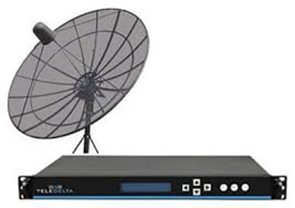
If we need to provide both groups of national and satellite digital channels, we will be required to implement information transfer procedures inside the building. Therefore, the transmission of information by copper lines from the antenna to amplifiers and switches in the floors and then to residential units became commonplace. The greatest cost of residential towers was the cost of the transmission lines, and most common problem of consumers was downward frequency along the way. For both groups of TV channels, due to their frequency difference, we are required to run two separate coaxial networks in the building. If a network is not built to transmit the frequency of satellite channels, the users will have to directly connect the satellite dish (from the nearest point of installation to the angle of view of the satellite) to the receiver, which, unfortunately, has a very inefficient effect on building facade and the use of systems.
Today, the implementation of fiber optic in residential buildings and residential areas has led to the concentration of satellite and television services in these areas, making the cost of the project more affordable than the old analog systems. As the fiber-optic communication platform is implemented to provide telecommunication services and the Internet in large projects, the use of this platform is also possible for the fast and high-quality transmission of images on television, satellite and internal intercom systems (videophone).
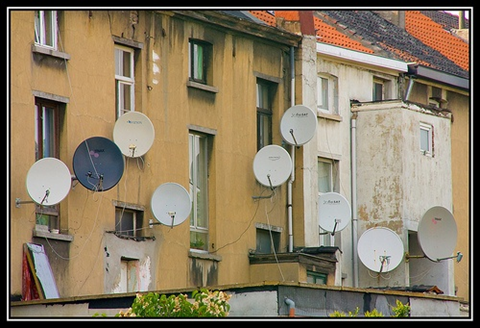
The central television and satellite system is implemented in a variety of ways in residential towns or commercial and office towers on fiber optics. An examination of each solution and its advantages and disadvantages is presented below.
1. TV and satellite on IP standard and IPTV technology
2. TV and satellite on the IP network as Multicast
3. Transmission and conversion of TV and satellite frequency on the optical fiber and eventually the re-conversion for user
4. OTT Television and satellite
5. Television and satellite from a widespread network such as telecommunications centers
6. Combined TV and Satellite and Internet
7. TV on the ONU RF port
1.TV and satellite on IP standard and IPTV technology
In this method, IPTV technology is used to send channel information to subscribers. Television networks, along with side services, is converted to IP protocol and ultimately transmitted to all units. Subscribers are required to use IP Setup box receivers for viewing TV channels. Today, most TV channel providers are delivering IPTV services around the world to subscribers.
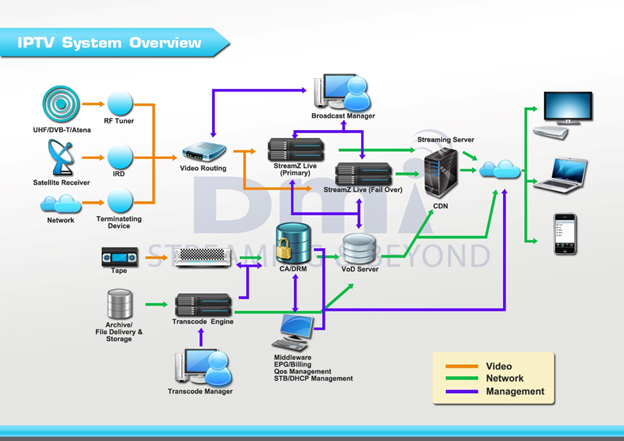
The main components of the IPTV network can be divided into several sections:
A. Encoding: The task of this section is the conversion of the data of satellite networks and television antennas into IP addresses. This is done by DVB equipment.
B. Archive: IPTV system provides users with a variety of services such as VOD. This service will allow access to archive including cinematic films, music and stored programs. This is possible with storage hardware and management software.
C. Access and encoding control section: The task of this section is to code live programs broadcasting from satellites or terrestrial networks, as well as coding archive programs for transfer to VOD servers, and its main goal is to prevent unauthorized access to resources and television programs.
D. Middle Ware Servers Including Advertising Server
The task of this server is to add ads and subtitles to the programs being broadcast. The task of Call digital record (CDR) server is to collect billing information as well as collect information about the most watched broadcasts and least watched shows and interest rate of various social groups to various programs, to guide policy makers as well as stakeholders in the field of cultural decision-making in the production of programs. Middleware servers are responsible for converting content and information for a variety of devices, such as television set, mobile phones, monitors, and more. In fact, the server's mission is to adapt to various types of STBs and middleware systems.
E. Subscriber Monthly Invoicing Section
F. Section for Sending Programs to Viewers
By examining the components of an IPTV system, you can disassociate unnecessary items from the system in commercial, administrative, or residential projects and redefined the system in order to economize on the project. The encoding section is required for a specific number of satellite and national channels, middleware and stream for several standard protocols such as H264, MPEG4 on the TV and other uses are optional. With this method, it will be possible to provide an affordable plan for residential tower and commercial and office centers. If FTTH infrastructure is implemented, the price will be moderated compared to the old analog system.
The Houper Group is offering various services in terms of capabilities and related systems trying to provide affordable services for various uses.
Advantages:
The system has the following functionality:
-Future development capabilities
-Ability to receive service from other IPTV provider centers, such as the Telecommunication Center or TV stations of other countries
-Standard IPTV protocol for use in other devices, such as computers and tablets
-Ability to restrict channels in the control center according to the needs of each customer
-Removal of satellite device and coaxial cabling
Disadvantages:
-Need for a reliable network infrastructure
-High cost of the common options
-Ability to restrict channels in the control center in the event of system development
-Requires Setup Box for Consumer
-License for each applicant
-Delay of 10 to 40 seconds to convert and display images based on hardware specifications
-Converting and displaying card channels (requiring the use of IPTV internet or hardware converters)
2. TV and Satellite on Multicast IP Network
In this method, the IP platform, or the network is used to transfer images and sound. Its infrastructure is like the IPTV infrastructure, but the encoding equipment also acts as a streamer, so only with a hardware device, it receives the information from satellite LNC and transmits to the port of the switch for delivery on the network. In this system, the receiver on the applicant's side only enters the transmitter's IP number. This method makes it impossible to manage the user, channel and frequency.
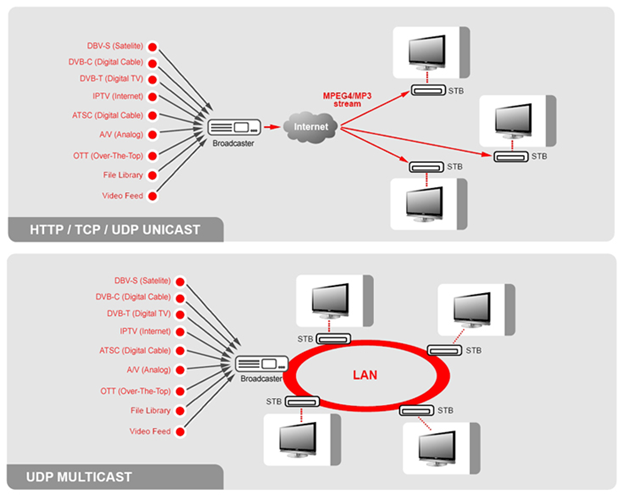
Advantages:
-Easy use and affordable
-Suitable for residential towers
Disadvantages:
-Broadcasting all channels for users
-Removing satellite device and coaxial cabling
-Broadcasting all channels for users and not being able to manage the channels personally
-Delay of 10 to 40 seconds to convert and display images based on hardware specifications
-Converting and displaying card channels (requiring the use of IPTV internet or hardware converters)
3.Transmission and conversion of TV and satellite frequency on the optical fiber and eventually the re-conversion for user
The above method is the best way to transfer information on fiber optic networks. In this method, the IP and network infrastructure is not used, and only the fiber-optic cables transmit the frequency. Coaxial cables are connected to a fiber optic converter, or we use a dish LNC with an optical fiber output. The information from fiber optics travel distant distances and reach the end users. On the user side and within the residential areas, the fiber-to-coaxial converter is used. In this way, the user will use a receiver or digital receiver according to his needs and will have full freedom to use all the capabilities of the networks.
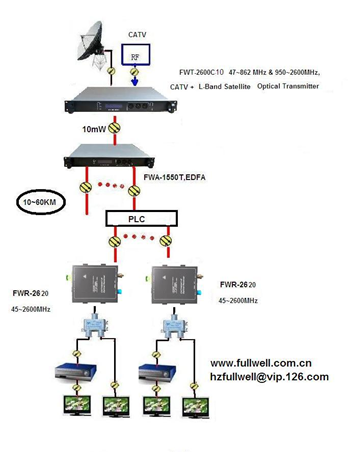
Advantages :
Affordable
Simple access similar to old systems
Diversity of channels to meet the user requirements
Lack of noise in transmission lines
Disadvantages:
Lack of access to IPTV features
Lack of extensibility to use new features in the future
Requires a digital receiver
4. OTT Television and satellite
OTT is an Internet TV that uses internet rather than the managed IP network. The development of Internet-enabled devices and high-end services like Netflix, Hulu and Apple iTunes have motivated more subscribers to receive video content at any time and place. Today, the Internet and CDNs are used to provide OTT services. These services are also provided on the Internet, and people can access them through home-screen TVs and other Internet-connected devices. OTT and IPTV have a common goal and it is sending video content to a number of recipients.
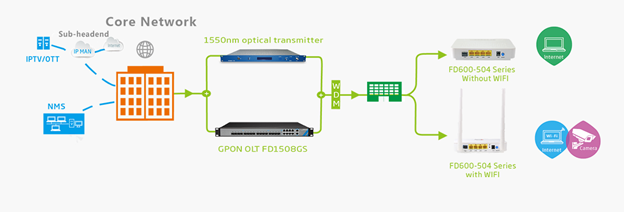
Advantages:
Possibility to receive images through the network and internet for all intelligent devices
Ability to provide various services
Disadvantages:
Suitable solution for large urban and national projects
Providing specific services such as digital signage in mega malls, and very large commercial and administrative centers
Delay of 10 to 40 seconds to convert and display images based on hardware specifications
5. Television and Satellite from a Widespread Network such as Telecommunications Centers
Many companies in the world offer IPTV services over the network and internet to customers bringing them a high added value. Organizations such as Telecommunications, and Broadcasting provide subscribers with monthly IPTV services. Therefore, high-rise building managers can use monthly fee to receive local networks and films and music archive. However, the Setup box will still be required on the receiving side.
Advantages:
No need for any IPTV related equipment in the center of the building
Use the IP infrastructure
Access to movie archives and information
Disadvantages:
Pay rent
Dependency on the service provider
Failure to use other networks
6. Combined TV and Satellite and Internet
A combination of the aforementioned solutions can also be a satisfactory way for building complex managers. Because if there is a proper infrastructure, it will be possible to use the simple multicast method or to convert the frequency to the optical fiber and to use the IPTV service of the organization. In any case, the broadcast of many television channels on the internet and network receivers is also commonplace and it will be a solution to remove surplus equipment at an affordable price of internet.
7. TV on the ONU RF port
This method is the most cost-effective and easiest way to implement video systems for commercial and office users. In this method, TV channels are converted by a converter and headend to 1550 nm wavelength, and after the OLT, it is put on the fiber optic network and FTTH with a multiplexing device. All RF-equipped ONUs can receive images and display them using the RF TV port and smart channel searching.
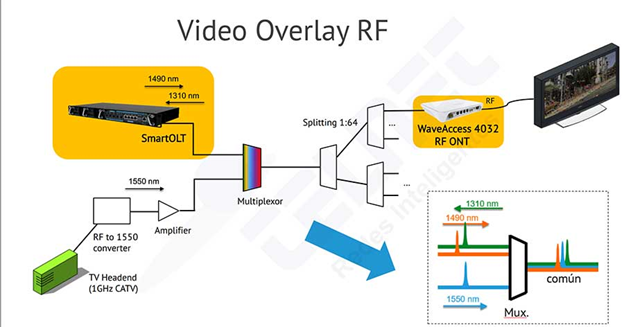
Advantages:
Affordable
Simple use similar to old systems
Diverse Channel
Lack of noise in transmission lines
No need for a receiver or digital receiver
Disadvantages:
Lack of access to IPTV features
Lack of extensibility to use new features in the future
Use of coaxial infrastructure
Need for analog switches if the number of displays is increased













